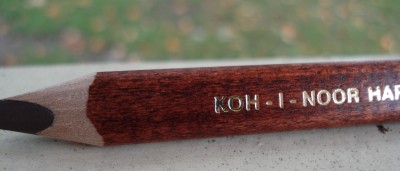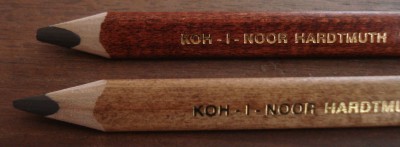
The Koh-I-Noor Triograph is an unusual offering. The oversized triangular shape along with the rich stained wood finish make these pencils seem like small pieces of furniture.
The pencil diameter is 10.5mm, and the core a very wide 6mm. It weighs 11 grams. To contrast this with other large triangular pencils, here are some statistics (all values approximate):
| Pencil | Weight | Diameter | Core | Sharpened | Cap |
| Koh-I-Noor Triograph | 11.2g | 10.5mm | 6mm | yes | finished |
| Faber-Castell Jumbo Grip | 7.3g | 9mm | 3mm | yes | unfinished |
| Dixon Tri-Conderoga | 7.1g | 7mm | 2mm | no | ferrule/eraser |
| Mongol Trio | 8.2g | 9mm | 3mm | no | ferrule/eraser |
Even compared with other oversize pencils, the Triograph is quite hefty.
Made in the Czech Republic, the pencil comes in three soft grades – 2B, 4B, and 6B. (Pictured are the 6B, with the darker stained wood, and the 2B.) They have a nicely finished black cap, and the stamping is in gold. The pencil’s wood stain surface is what makes it so unusual. It really does look like something that shouldn’t be disposable.

The lead is dark and rich, and certainly quite usable. The finish is unique, quite different from any other pencil I’ve seen. The large triangular shape will be a deciding factor for many. It’s large enough that you either like the feel or not. As well, like the International Arrivals pencils, it’s too wide for even the wide hole in dual hole sharpeners. This puts it in sharpen-by-knife territory, which may or may not be something you’re fine with.


